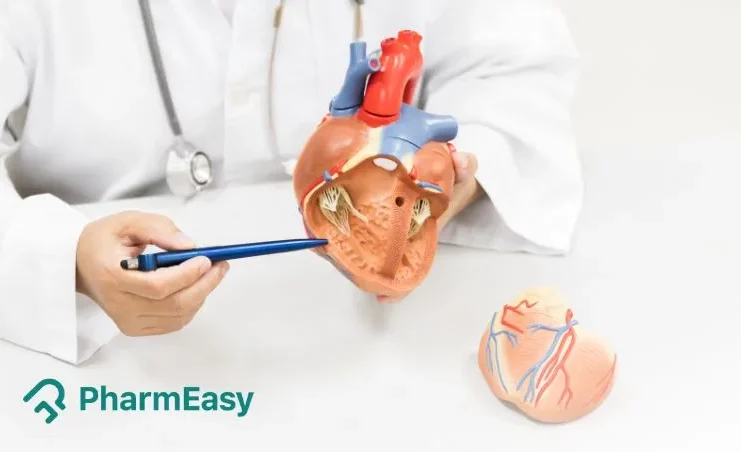Classes & Stages of Heart Failure
By Dr. Ameya Tirodkar +2 more

Get,

to manage your symptom
Get your,


4 Cr+ families
benefitted

OTP sent to 9988776655



You’ve successfully subscribed to receive
doctor-approved tips on
Whatsapp

Get ready to feel your best.

Hi There,
Download the PharmEasy App now!!


Register to Avail the Offer
Send OTPBy continuing, you agree with our Privacy Policy and Terms and Conditions

Hi There,
Sign up on PharmEasy now!!
Trusted by 4 crore+ families

OTP sent to 9988776655



You have unlocked 25% off on medicines




Code: NU25
By Dr. Ameya Tirodkar +2 more
Table of Contents
Heart failure is a widespread condition affecting over 64 million people across the globe1,2. Despite its name, heart failure doesn’t mean the heart has stopped working; it means the heart isn’t pumping blood as it should2,3. This condition may cause serious health challenges, leading to reduced functional capacity, a lower quality of life, and increased medical costs1,2.
Heart failure often stems from other underlying health issues, and its severity can vary widely. So, doctors use classification systems to describe its progression and impact. The two most commonly used systems include the New York Heart Association (NYHA) system and the American College of Cardiology (ACC)/American Heart Association (AHA) staging. These classifications can be essential for monitoring disease progression and guiding treatment decisions4.

In this article, we’ll guide you through the different heart failure stages and classes so you can better understand the condition and ensure treatment adherence to improve outcomes.
Heart failure occurs when the heart muscles do not stretch efficiently and lose their ability to pump blood properly. This means your body may not get enough oxygen-rich blood to meet its needs, affecting various organs and causing a range of symptoms5.
Heart failure can affect individuals differently and symptoms can range from mild to severe, which can worsen over time4,5. In the early stages, you might only notice them during physical activity. As the condition progresses, symptoms can become more persistent, even at rest. In some cases, heart failure symptoms may appear suddenly, especially after a heart attack or another serious heart-related event5.
Common symptoms of heart failure include5,6:
Heart failure typically develops as a result of other underlying health conditions that damage or strain the heart over time. More often it occurs gradually due to conditions that weaken the heart muscle over time, reducing its ability to pump blood effectively4.
Here are some of the most common causes of heart failure4,5,7:
When blood pressure remains elevated over time, it puts extra stress on the heart. This pressure makes the heart work harder, eventually leading to thickening or weakening of the heart muscle and, in some cases, heart failure.
This condition arises when the arteries delivering blood to the heart become narrowed/obstructed. As a result, the heart has to work harder to circulate blood, which over time can weaken the heart muscle and reduce its pumping ability.
A heart attack may sometimes leave behind some tissue (usually scar tissue) that could disrupt the heart’s normal pumping function.
Other health conditions that may contribute to heart failure include:
Moreover, certain medications can also contribute to or worsen heart failure, especially if they interfere with how the heart or other prescribed heart medications work. These include4,8:
The heart has two sides: the left side, which pumps oxygen-rich blood to the body, and the right side, which pumps oxygen-poor blood to the lungs to pick up oxygen. Heart failure can affect different parts of the heart, based on which, the main types of heart failure include:
This happens when the left side of the heart becomes either weakened or stiff. There are two main subtypes based on how well the heart is pumping blood4,9:
Right-sided heart failure happens when the right side of the heart is unable to pump blood effectively to the lungs. It’s often a consequence of left-sided heart failure. When this happens, pressure backs up into the lungs, often putting extra strain on the right side of the heart. Eventually, the right side weakens too. As a result, blood backs up into the body’s veins, leading to swelling and other symptoms4,9.
Congestive heart failure refers to the buildup of fluid in the body’s tissues, including the lungs. This may occur due to the heart’s inability to pump blood efficiently9.
Before we move onto understanding why the knowledge on heart failure stages is important, let’s have a look at the two main classification systems used to determine how advanced your heart failure is:
The NYHA system focuses on how heart failure affects your ability to be active. It’s based on symptoms you experience during physical activity and can change over time as your condition improves or worsens4:
This classification is helpful for adjusting treatments depending on how you’re feeling at any given time.
Developed by the ACC and the AHA, this system focuses on the development of heart failure over time. Once you’re diagnosed at a specific stage, you remain at that stage or may progress further4. Now, let us look at what the 4 stages of congestive heart failure are:
Knowing different heart failure stages is key to taking control of your health. Staging helps you and your doctor understand how much your heart is affected, so you can adjust your diet, activity, and medications to keep symptoms under control. Your stage also guides treatment choices from medications and lifestyle changes in early stages to devices or surgery in advanced cases. Understanding your stage helps you make informed decisions, set goals, and make plans for your heart health. In all, it is the first step toward better control, better care, and better living.
Heart failure is typically diagnosed based on a person’s symptoms and physical examination. However, some tests can help understand the underlying cause, arrive upon a potential diagnosis and guide further treatment10. Here’s how your doctor may evaluate your condition:
An echocardiogram uses sound waves to create live images of the heart, showing how well it pumps and how the heart valves are functioning10.
This quick, painless test uses small sensors (electrodes) placed on your skin to measure the electrical activity of your heart, measure heartbeats, and rhythm4.
Various imaging tests, such as the following, may be used to assess the structure and function of the heart more in detail10:
These tests check how well the heart works under pressure and include10:
Blood tests may help provide useful insights about your heart health. Common blood tests include10:
Heart failure is typically a lifelong condition, but with the right medical guidance, many people are able to manage symptoms and lead a fulfilling life. Below are some effective ways11:
Adopting a heart-healthy lifestyle is essential. This includes eating a balanced, low-sodium diet, exercising regularly (as advised by your doctor), losing weight, quitting smoking, limiting alcohol, and managing stress. You may also ask your doctor about cardiac rehabilitation programs that could help support these changes.
The majority of people with heart failure will require a combination of medications to manage symptoms and enhance heart function. Common medication classes include:11
It is important to take these medications under medical supervision to avoid potential side effects.
A pacemaker is a small device implanted under the skin that helps maintain a regular heart rhythm, especially in those whose heart beats too slowly.
In some patients, the left and right chambers of the heart don’t beat in sync. CRT uses a special pacemaker with multiple leads to coordinate the timing of heart muscle contractions, improving the heart’s efficiency and output.
For individuals at high risk of life-threatening heart rhythms, an ICD can monitor and manage abnormal rhythms by delivering an electric shock if needed. This may help avoid sudden cardiac death.
Some patients benefit from devices that combine both CRT and defibrillator capabilities (known as CRT-Ds). These offer the dual benefits of improved pumping efficiency and protection from dangerous arrhythmias.
These are small devices implanted in the pulmonary artery to monitor heart pressures remotely. They transmit data to your doctor or his team, helping them adjust treatment before symptoms worsen.
In the last stages of heart failure, mechanical support devices like LVADs can help the heart pump blood. These are used either as a temporary support before a heart transplant or as a long-term management option.
Surgery may be needed in certain cases or in the last stages of heart failure. Common types include:
In some cases (such as stage 4 heart failure), a heart transplant may be the only viable option5,10.
Spotting the warning signs early can help avoid serious health complications. It’s important to stay alert to any changes in your health condition and know when to contact your doctor or seek emergency care.
Call your doctor if you notice5:
Get emergency help right away if you5:
Managing heart failure requires a combination of lifestyle changes, regular monitoring, and the right treatment plan. It is crucial to recognise symptoms early, get a proper diagnosis, understand heart failure stages, and know when to seek medical attention, all of which are key to improving quality of life and overall outcomes. Always stay in touch with your doctor and take proactive steps toward better heart health.
In stage D heart failure, signs of poor blood flow may include low blood pressure, slow return of colour to the skin after pressing it, cold hands and feet, feeling confused (or unable to think clearly), and peeing less than usual1.
Stages (A to D) show how heart failure develops and gets worse over time. Classes (I to IV) describe how much your daily activities are affected by symptoms. Together, they help doctors understand your condition and decide the best treatment4.
While heart failure is usually a long-term condition, treatment and lifestyle changes may help improve symptoms. However, stages usually don’t go backwards4.
Rest helps your heart recover, especially after activity, eating, or exercise. Getting enough rest throughout the day can help manage your symptoms and improve your energy5.
Yes, staying active could be helpful. However, it is ideal to seek advice from your doctor. They will efficiently guide you based on your individual condition5.
1. Shams P, Malik A, Chhabra L. Heart failure (congestive heart failure) [Internet]. Treasure Island (FL): StatPearls Publishing; 2025 [updated 2025 Feb 26; cited 2025 Apr 10]. Available from: https://www.ncbi.nlm.nih.gov/books/NBK430873/
2. Savarese G, Becher PM, Lund LH, Seferovic P, Rosano GMC, Coats AJS. Global burden of heart failure: a comprehensive and updated review of epidemiology. Cardiovasc Res. 2023 Jan 18;118(17):3272-3287. doi: 10.1093/cvr/cvac013. Erratum in: Cardiovasc Res. 2023 Jun 13;119(6):1453. doi: 10.1093/cvr/cvad026. PMID: 35150240. Available from: https://pubmed.ncbi.nlm.nih.gov/35150240/
3. National Heart, Lung, and Blood Institute. Heart failure [Internet]. National Institutes of Health; [cited 2025 Apr 10]. Available from: https://www.nhlbi.nih.gov/health/heart-failure
4. Johns Hopkins Medicine. Heart failure [Internet]. Johns Hopkins University; [cited 2025 Apr 10]. Available from: https://www.hopkinsmedicine.org/health/conditions-and-diseases/heart-failure
5. MedlinePlus. Heart failure – congestive [Internet]. U.S. National Library of Medicine; [updated 2024 July 14; cited 2025 Apr 10]. Available from: https://medlineplus.gov/ency/article/000158.htm
6. Centers for Disease Control and Prevention (CDC). Heart failure [Internet]. CDC; [updated 2024 May 15; cited 2025 Apr 10]. Available from: https://www.cdc.gov/heart-disease/about/heart-failure.html
7. British Heart Foundation. Heart failure [Internet]. BHF; [cited 2025 Apr 10]. Available from: https://www.bhf.org.uk/informationsupport/conditions/heart-failure
8. Cleveland Clinic. Cardiotoxicity: Cancer treatment and the heart [Internet]. Cleveland Clinic; [cited 2025 Apr 11]. Available from: https://my.clevelandclinic.org/health/diseases/16858-chemotherapy–the-heart-cardiotoxicity
9. American Heart Association. Types of heart failure [Internet]. AHA; [updated 2023 Mar 23; cited 2025 Apr 10]. Available from: https://www.heart.org/en/health-topics/heart-failure/what-is-heart-failure/types-of-heart-failure
10. MedlinePlus. Heart failure – when to call the doctor [Internet]. U.S. National Library of Medicine; [updated 2022 Oct 04; cited 2025 Apr 10]. Available from: https://medlineplus.gov/ency/patientinstructions/000366.htm
11. NHS. Heart failure – Treatment [Internet]. National Health Service (UK); [updated 2022 May 19; cited 2025 Apr 10]. Available from: https://www.nhs.uk/conditions/heart-failure/treatment/
Disclaimer: The information provided here is for educational/awareness purposes only and is not intended to be a substitute for medical treatment by a healthcare professional and should not be relied upon to diagnose or treat any medical condition. The reader should consult a registered medical practitioner to determine the appropriateness of the information and before consuming any medication. PharmEasy does not provide any guarantee or warranty (express or implied) regarding the accuracy, adequacy, completeness, legality, reliability or usefulness of the information; and disclaims any liability arising thereof.

Leave your comment...
Comments